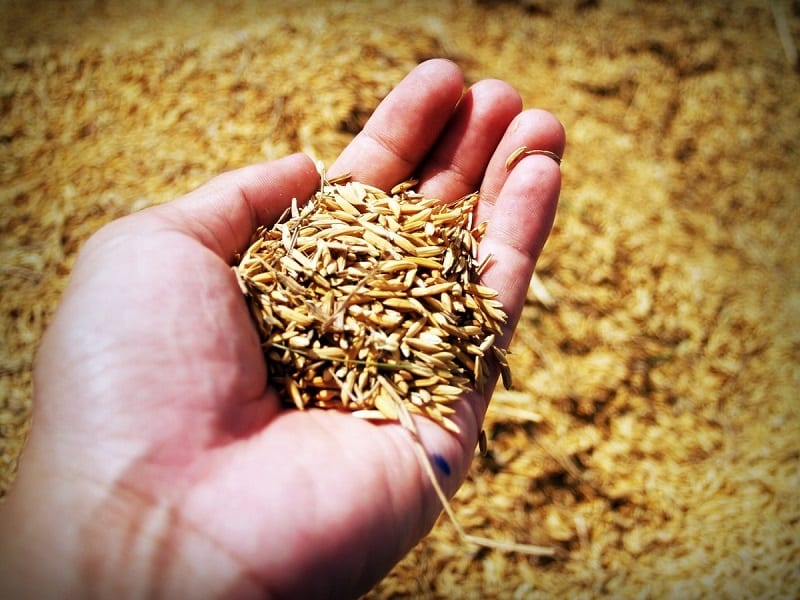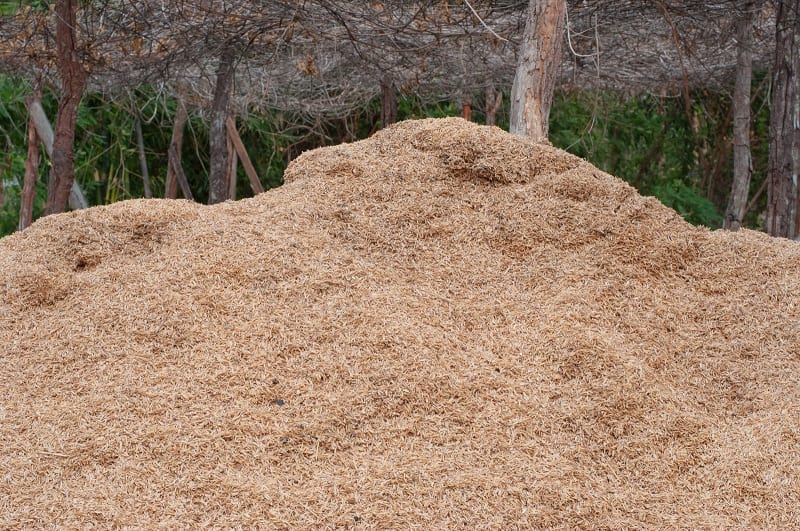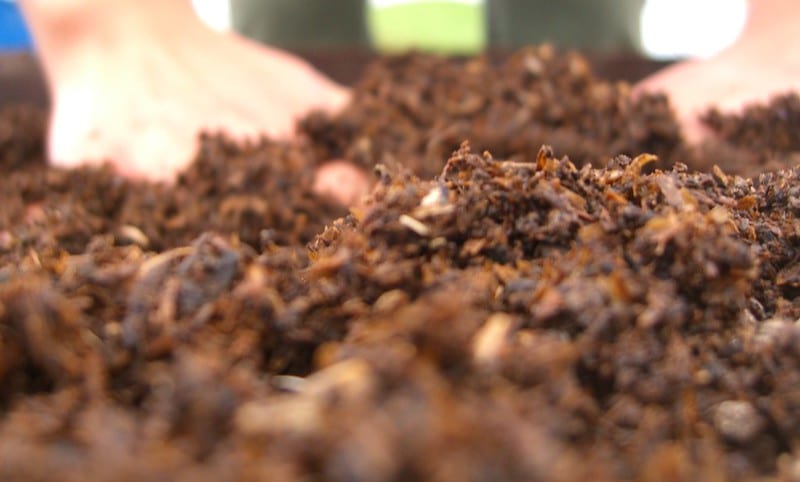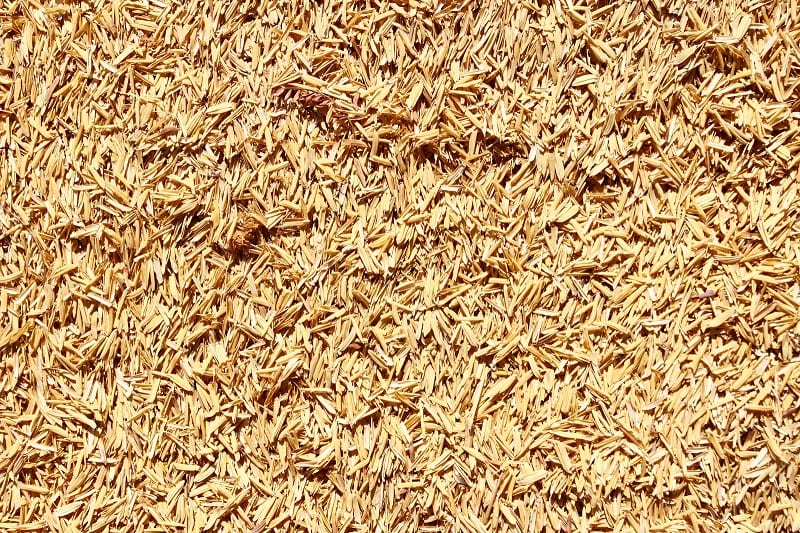
In this article, we will teach you how you can use rice hulls in gardening. When properly applied, they improve soil drainage, water-holding capacity, and aeration. Unlike perlite and other rock products, however, rice hulls do not require mining.
Unlike peat, their production does not require the disruption of ecosystems in bogs, swamps, and mangrove forests. Like coco coir, they are a byproduct of agriculture that would otherwise be considered waste.

Rice hulls are thin husks that act as a protective covering for rice grains. Millers remove them after harvest. They are non-toxic and biodegradable and feed the soil as they break down.
Rice Hulls as Sustainable Soil Amendment
Contents
That’s why more and more gardeners and companies in the commercial potting industry supplement their peat mix with rice hulls. By utilizing rice hulls in gardening, individuals can decrease their reliance on peat, a resource that is depleted at a faster rate than nature can replenish.
Here’s how you can use rice hulls in gardening, particularly as a soil amendment.

How to Use Rice Hulls in the Garden
For your garden, spread about a two-inch layer of rice hulls across the surface when you fertilize your plots in the spring. Mix it into the top 6 to 12 inches of the soil. For potted plants, a 10 to 50 percent ratio of rice hulls in your potting soil is adequate.

You can use rice hulls in gardening, as mulch, just like you use straws to retain moisture and fend off weeds. Research has found that rice hulls provide effective weed control when mixed into the top ½ to 1-inch of soil.
The rice hulls are extremely lightweight. This desirable quality of rice hulls in gardening plays a vital role in facilitating optimal plant growth as it enables plants to efficiently acquire the essential oxygen they require through their root systems.

The Magic of Rice Hulls in Gardening
Rice hulls, often overlooked and discarded, hold tremendous potential in enhancing your gardening endeavours. As a versatile and sustainable resource, rice hulls in gardening offer numerous benefits for soil health, moisture retention, weed control, and more.
1. Improving Soil Structure
One of the key advantages of rice hulls in gardening is their ability to improve soil structure. Their lightweight and porous nature creates air pockets, enhancing soil aeration and preventing compaction. To effectively utilize rice hulls for soil improvement, incorporate them into your garden beds or mix them with potting soil.
The use of rice hulls in gardening provides many advantages. Their presence creates a well-draining and friable environment that promotes root growth and nutrient uptake. The loose soil texture it produces promotes the growth of beneficial microorganisms, earthworms, and other soil-dwelling organisms that aid in overall soil health.
Using rice hulls in gardening practices creates an ideal habitat for beneficial microorganisms, earthworms, and other soil-dwelling organisms. These organisms play crucial roles in soil health by breaking down organic matter, releasing nutrients, and improving soil structure. As rice hulls decompose, they provide a continuous source of organic material, sustaining microbial activity and enhancing overall soil fertility.
The loose texture of soil enriched with rice hulls promotes better soil aeration. This is essential for root respiration and the growth of aerobic microorganisms. Improved soil aeration prevents compaction and anaerobic conditions, creating a healthier environment for plant roots to thrive.
Rice hulls have a neutral pH, which means they do not significantly alter the acidity or alkalinity of the soil. This makes them suitable for use in a wide range of soil types without affecting the pH balance. Gardeners can incorporate rice hulls in gardening practices, especially when dealing with acidic or alkaline soils without concern for pH imbalances.
2. Enhancing Moisture Retention
Conserving moisture is vital for plant health, particularly in hot and dry climates. Rice hulls excel in retaining moisture due to their ability to absorb and hold water. Incorporating rice hulls in gardening routines, and using them as a mulch layer, helps regulate soil moisture levels, reducing water evaporation and ensuring a more consistent water supply to your plants.

This efficient moisture management can enhance the resilience and vitality of your garden, especially during periods of drought.
The structure of rice hulls enables them to absorb and retain moisture efficiently. When incorporated into the soil, rice hulls act like tiny sponges, soaking up excess water during periods of rainfall and gradually releasing it back into the soil as needed. This ensures a consistent and adequate supply of moisture to plant roots, even in the absence of regular irrigation.
By forming a protective layer over the soil surface, rice hulls help mitigate water loss through evaporation. During drought conditions, when water is scarce, this mulch-like barrier minimizes moisture loss due to sun exposure and wind. As a result, the soil retains more moisture for longer periods, reducing the frequency of watering required to sustain plant growth.
Drought often exacerbates soil erosion, as dry, compacted soil is more prone to being swept away by wind or water. The use of rice hulls in gardening, like when you spread them over the soil surface, creates a protective barrier that shields the soil from erosive forces. This helps maintain soil integrity, preventing loss of valuable topsoil and protecting plant roots from exposure.
In search of moisture, plant roots naturally grow deeper into the soil. The moisture-retentive properties of rice hulls encourage this deep root growth, enabling plants to access water stored deeper in the soil profile. Deep-rooted plants are more resilient to drought stress, as they can tap into additional water reserves, ensuring their survival and vitality during prolonged dry spells.
By conserving moisture within the soil and reducing the need for frequent irrigation, rice hulls contribute to sustainable water conservation practices in the garden. This not only conserves precious water resources but also promotes environmental sustainability by minimizing water usage and runoff.
3. Controlling Weeds
Weeds can be a persistent nuisance in any garden, competing with your plants for resources. Rice hulls offer an effective solution for weed control. By spreading a layer of rice hulls as a mulch around your plants, you can create a physical barrier that inhibits weed growth.
Additionally, rice hulls in gardening act as a natural weed suppressant by blocking sunlight and reducing weed germination. So, you can say goodbye to excessive weeding and enjoy a cleaner, more manageable garden with the help of rice hulls.
Rice hulls create a dense covering over the soil, effectively smothering any weed seedlings that manage to germinate. This prevents them from establishing roots and competing with your desired plants for water, nutrients, and space. As a result, you spend less time pulling weeds and more time enjoying your garden.
With weed growth suppressed you’ll spend less time and effort on the tedious task of weeding. The use of rice hulls in gardening, like as a natural weed suppressant reduces the need for constant weeding, allowing you to focus on other aspects of garden maintenance or simply relax and appreciate your outdoor space.
4. Promoting Sustainable Gardening Practices
Using rice hulls in gardening endeavours contributes to sustainable practices. Rice hulls are a byproduct of rice production, making them a readily available and eco-friendly resource. By incorporating rice hulls in gardening practices, you not only maximize their benefits but also reduce waste and support a circular economy.
Embracing the use of rice hulls in gardening aligns with environmentally conscious gardening practices, helping to minimize your ecological footprint and promote a greener future.
Reducing Pressure on Limited Resources
Rice hulls in gardening are similar to coco coir and sphagnum peat moss but are more sustainable, according to Grow Organic. Unlike these typical soil amendments, rice hulls also boast a neutral pH, making them excellent for balanced soils that require a boost in organic matter.
Gardening products that offer benefits both to the individual gardener and contribute to reducing strain on limited resources hold significant value.
The importance of sustainability is widely recognized on a global scale. Just as oil and water are finite resources, the same holds for other limited reserves. Once depleted, they cannot be replenished. Our natural environment falls into this category of finite resources.
Incorporating sustainable materials in our gardens becomes essential for the well-being of our planet. By embracing sustainable practices and utilizing environmentally friendly materials, we contribute to the preservation of our natural resources and create a more sustainable future for generations to come.
Beautiful Gardens Out of Rice Hulls
Rice hulls can be used year-round in gardening, providing a versatile and enduring source of beauty. Whether used as mulch in the summer to suppress weeds and retain moisture or as a soil amendment in the winter to enrich the soil, rice hulls contribute to the garden’s beauty throughout the seasons.
Having rice hulls in gardening practices can result in a beautiful garden that is not only visually stunning but also environmentally sustainable and low-maintenance. With weed-free beds, healthy soil, consistent moisture, and a commitment to sustainability, gardens featuring rice hulls are a testament to the beauty that can be achieved through mindful and eco-conscious gardening.
Harnessing Rice Hulls for Gardening Success
With their remarkable versatility and numerous advantages, rice hulls have emerged as a valuable tool for effective gardening. From improving soil structure and enhancing moisture retention to controlling weeds and promoting sustainable practices, having rice hulls in gardening routines can yield impressive results.
Incorporating rice hulls in gardening practices holds immense potential for achieving remarkable results. By following the simple tips and techniques outlined in this guide, you can harness the power of rice hulls to create an optimal soil structure, promote healthy plant growth, and foster a thriving garden ecosystem.
Experience the advantages offered by rice hulls and observe your garden thrive with lively and flourishing plants.
Frequently Asked Questions
1. Why do you use rice hulls in gardening?
Rice hulls are the outer protective layer of rice grains, often discarded during rice milling. Incorporating rice hulls in gardening practices, as a sustainable mulch or soil amendment to suppress weeds, retain moisture, improve soil structure, and provide nutrients as they decompose.
The lightweight and porous nature of rice hulls contributes to soil structure enhancement. When incorporated into the soil, they create air pockets, improving soil aeration and drainage. This prevents soil compaction, facilitates root penetration, and fosters a conducive environment for healthy root development and nutrient uptake.
2. How do rice hulls in gardening practices help you?
Rice hulls create a physical barrier over the soil, blocking sunlight and preventing weed seeds from germinating. This helps reduce weed growth, minimizing the need for manual weeding and keeping garden beds tidy.
The dense coverage provided by rice hulls effectively smothers weed seeds, preventing them from accessing essential resources like water and nutrients. Without these vital elements, weed seeds are unable to germinate and establish themselves in the soil.
3. Are rice hulls suitable for all types of plants?
Yes, rice hulls are versatile and suitable for various types of plants, including vegetables, flowers, shrubs, and trees. They provide benefits such as moisture retention, weed suppression, and improved soil structure, promoting healthy growth for a wide range of plants.
Rice hulls excel at retaining moisture in the soil, which is beneficial for all types of plants, especially those with shallow roots or those sensitive to drought conditions. Consistent soil moisture promotes healthy growth and prevents wilting.
Regardless of the plant species, weeds can be a persistent nuisance in any garden. By using rice hulls as mulch, you create a barrier that inhibits weed growth by blocking sunlight and suffocating weed seeds. This benefits all plants by reducing competition for nutrients and space.
The lightweight and porous nature of rice hulls contributes to improved soil structure by promoting better aeration and drainage. This is advantageous for all plants as it prevents soil compaction, encourages root development, and facilitates nutrient uptake.
4. Do rice hulls attract pests or promote fungal growth?
No, rice hulls are generally pest-resistant and do not promote fungal growth when used properly. Their lightweight and airy texture allows for good air circulation, minimizing the risk of fungal diseases. Additionally, rice hulls are naturally repellent to many pests.
Rice hulls contain silica, a compound that naturally deters many common garden pests. This inherent pest-resistant property helps prevent insect infestations in the garden, reducing the risk of damage to plants.
The lightweight and airy texture of rice hulls promotes good air circulation when used as mulch or soil amendment. Adequate air circulation minimizes moisture retention in the soil, which is crucial for preventing fungal diseases. By keeping the soil well-aerated, rice hulls help create an environment less conducive to fungal growth.
5. How often should rice hulls be replenished in the garden?
The frequency of replenishing rice hulls depends on factors such as weather conditions, soil type, and the rate of decomposition. In general, a layer of rice hulls may need to be replenished annually or as needed to maintain the desired thickness for weed suppression and moisture retention.
Regions with heavy rainfall or extreme weather conditions may experience faster decomposition of rice hulls. In such areas, more frequent replenishment may be necessary to maintain the desired thickness of mulch for effective weed suppression and moisture retention.
Soil composition can also influence the rate of decomposition of rice hulls. Sandy soils tend to have better drainage and may require more frequent replenishment, while clay soils may retain rice hulls for a longer duration.
6. Can rice hulls be composted?
Yes, rice hulls can be added to compost piles or bins as a source of carbon-rich material. They decompose slowly, adding organic matter to the compost and improving its overall quality. However, since rice hulls decompose slowly, they are often used more effectively as a mulch or soil amendment directly in the garden.
Rice hulls decompose slowly due to their high lignin content and tough outer layer. While they do break down over time, the process is gradual, and it may take longer for rice hulls to fully decompose compared to other organic materials in the compost pile.
When used as a mulch or soil amendment in the garden, rice hulls provide immediate benefits such as weed suppression, moisture retention, and improved soil structure. Their slow decomposition rate allows them to serve these purposes effectively over an extended period, making them valuable additions to garden beds and soil.
7. Are rice hulls safe for organic gardening?
Yes, rice hulls are a natural and organic material, making them suitable for use in organic gardening practices. They do not contain synthetic chemicals or additives, making them an environmentally friendly option for weed suppression and soil improvement.








